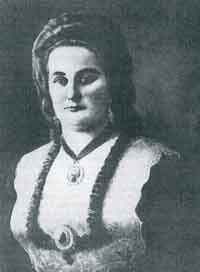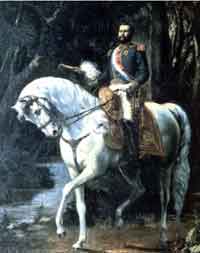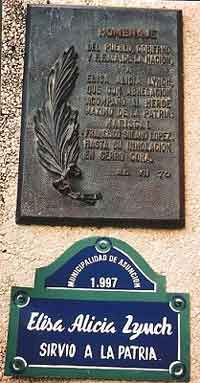|
Once upon a time in a
faraway land,
there lived an ugly Prince
who dreamt
of a beautiful Irish Princess
|
|

Eliza Lynch (1835-1886)
(from Williams, 1979) |
Whether as
a result of lack of direct knowledge of Latin American cultures
or due to plain ignorance, European imagery of the continent
abounds with legendary narratives and
prejudicial accounts, frequently manifesting themselves as
portrayals of natural anomalies. According to
Claude Lévi-Strauss, 'it is likely that the term barbarous
etymologically refers to the confusion and lack of
articulation perceived in the voices of certain birds, as
opposed to the signifying value of human speech. Similarly,
wild (sauvage) means "belonging to the forest", and
refers to the animal kingdom, as opposed to human beings. In
both cases the fact of cultural diversity is neglected, and
all that is not within our world is rejected and located outside of culture, in the natural world.' (Lévi-Strauss 1987:
20).
Few aspects of
relations between Ireland and Latin America have been as
popular as the fate of the San Patricio battalion in the
United States-Mexican War (1846-1847) and the life of Eliza
Lynch (1835-1886). In accordance with Mikhail Bakhtin's
categories for literary criticism, the San Patricios and Eliza
Lynch are the only Irish-Latin American chronotopes who
are the subjects of the work of historians as well as
spawning a number of fictional works. The San Patricios
battalion even inspired a Hollywood film, One Man's Hero, directed by Lance Hool in
1999. However, most texts relating to the San Patricios are historical studies, or at least popular history books.
The
prolific bibliography on Eliza Lynch, a Cork-born courtesan in
Paris who became the unofficial first lady of Paraguay during
the rule of Francisco Solano López (1826-1870), covers not
only history books and essays, but also novels, short stories
and poetry, and spans the period from the era of South
American historical revisionism in the early twentieth century
to the exploitation of the lucrative market for historical
novels in present-day Ireland and Irish North America.
The fertile
field for both historiography and fiction writing in Spanish,
English, French or Guaraní, one of the most important
indigenous languages of Paraguay, presents at least three
possible levels of audience analysis of Eliza Lynch’s story.
First, that Lynch lived a hazardous life, characterised by
numerous exciting episodes with manifold concrete and
psychological meanings which historians take pleasure in
recording and accounting for in an endless series of
biographies. Second, novelists relish the challenge of using
fiction to fill in the gaps in the recorded periods or aspects
of her life, enriching with their craft an already colourful
life. Finally, the readers of biographies and novels based on
Eliza Lynch's life enjoy the freedom of inventing a place and
a period in which everything, or almost everything, is
perceived as possible to a creative and wilful mind.

Some of the biographies of
Eliza Lynch: Cawthorne (2003), Rees (2003), Enright
(2002), and Varela (1997). |
There are
underlying aspects of the fascination with the history of
Eliza Lynch which merit closer examination. In societies where
women are considered inferior to men by the vast majority of
people, whether men or women, it is attractive and somehow
comforting to read the story of at least one woman who,
availing of her seductive and intelligent personality, managed
to attain the highest position in a country, even if she
subsequently lost that position. Another interesting aspect is
the juxtaposition of Eliza Lynch's presumed humble origins and
her attainment of a high social rank. Despite the fact that
her father was a physician and she came from a middle-class
family in Cork , the relatively impoverished context in which
she lived during her formative years is frequently emphasised
to create the illusion of a strong character capable of
changing her life and achieving social mobility. Finally, the
fact that she was European, and more precisely Irish, should
not be overlooked in the context of her cultural contact with
a post-independence South American country. It is here that
many works about Eliza Lynch, fictional works in particular, frequently have recourse to the beauty-and-the-beast paradigm.
According to
this paradigm a couple, traditionally a man and woman, are
united by some circumstance and become lovers. The peculiar
quality of this relationship is that one of them, usually the
man, less frequently the woman, is a monster or belongs to the
world of the supernatural. Most renderings of beauty and the
beast portray the latter as essentially a civil and kind
being, who only appears superficially to be brutal or
repulsive. Therefore the beauty's efforts are not aimed at
changing the beast but at discovering and falling in love with
the gentle spirit hidden behind a fierce appearance. Typically
in the closing passages of these narratives, the uglier of the
two turns into a handsome - and frequently wealthy - person
through the healing benefits of love. Incidentally, I was
unable to locate any version in which the ex-monster
subsequently reverted to its previous state, a fact that would
be quite logical yet rather disturbing for the reader.
|

Francisco Solano López
(1826-1870) |
The first
recorded fictional beauty-and-the-beast couple featured in
Madame de Villeneuve's collection La jeune Amériquaine et
les Contes marins (The Hague,
1740). However, a more inclusive account should include almost all
Indo-European cultures. According to the Swedish
anthropologist J-Ö. Swahn, there are over 1,100 variations of
the beauty-and-the-beast narrative. In the animal kingdom,
women fall in love with butterflies, dogs, wolves, snakes or
toads, and men with ravens, goats, warblers, frogs or cats. In
the world of fantasy, the combination of animal body-parts,
for example a wolf's head with a snake's body, or of animal
and human bodies, has generated an endless series of monsters.
One common feature of the monsters is that they are mute, or
unable to communicate through a human form of speech.
Glen Keane, the
supervising animator of the Beast in Walt Disney's movie
Beauty and the Beast (1991) 'spent months surrounded by a
bestiary of animals for inspiration, including a mandrill in
the London Zoo named Boris and a gorilla named Caesar in the
Los Angeles Zoo' (Disney Online, 2003). Beast was
inspired by the mandrill and later developed to incorporate
elements of the bear and the wolf, but was principally based
on the buffalo.
The Irish Beauty and the Paraguayan Beast
One recent
biography of Eliza Lynch, The Empress of South America
by Nigel Cawthorne [1], represents a
telling illustration of the beauty-and-the-beast paradigm. The
author describes Lynch in exuberant language, 'she was tall
and supple with a delicate figure admired for its beautiful
and seductive curves. Her hair was reddy gold, her skin
calcium white and her eyes "a blue that seems borrowed from
the very hues of heaven"' (Cawthorne 2003: 63). In contrast,
Francisco Solano López was 'the most unappealing of an
unattractive family, [...] short, fat, ugly, barrel-chested
and bandy-legged from learning to ride early in life. [...] He
had a gross animal look that was repulsive when in repose. His
forehead was narrow and his head small, with the rear organs
largely developed. His teeth were very much decayed, and so
many of the front ones were gone as to render his articulation
somewhat difficult and indistinct' (47). There is no doubt as
to who is depicted as the beauty and who as the beast,
particularly as the latter demonstrated the traditional
feature of the beast, that of the inability to speak.
|

House of Eliza Lynch in
Asunción (currently, the School of Law).
(Universidad Nacional de Asunción) |
Lévi-Strauss
has explained that 'the original sin of anthropology is the
conflation of purely biological notions of race – if these
notions have any validity, a suggestion that modern genetics
rejects – and the sociological and psychological productions
of human culture (Lévi-Strauss 1987: 10). According to
Cawthorne, the moral qualities of his characters reflect their
physical features. Eliza Lynch was 'strong and
independent-minded' (Cawthorne 2003: 59) and, citing Héctor Varela, she 'had
an expression of ineffable sweetness' (64). To illustrate her
intelligence, Cawthorne mentions that she was 'educated,
cultivated and sophisticated' (77), 'mastered French, Spanish
and Guaraní, the tongue-twisting Indian language of Paraguay
and she was the cultural superior of even the most highly
educated in Paraguay at the time' (54). In fact the author
also acknowledges Eliza Lynch's profession in Paris as that of
grande cocotte (courtesan), along with describing her
endless ambition and greed in her relations with Solano López,
and her cruel treatment of the Paraguayan people. Though
Irish-born, Eliza 'thought of herself as an Englishwoman'
(211), was proud of being a British subject and her
'sympathies seem to have extended only to English speakers'
(205). Perhaps influenced by Eliza's charisma and their common
Irish origin, the United States consul Martin T. McMahon, who
according to Cawthorne conducted a romance with Lynch,
reported that she was 'a lady of Irish parentage, of English
birth, and of French education' (244).
As for Solano
López, his negative definition in opposition to the beauty
suffices to characterise the beast. However, Cawthorne further
relates that he was 'spoilt, arrogant, boastful and greedy.
[...] He had no knowledge of music, art, literature or the
classics' (48). He 'did not understand [...] the use of Latin
quotations, [and did not hear of] classical authors' (236).
His moral profile was characterised by a 'weakness for young
aristocratic virgins' (49). While in Paris, 'he went drinking,
gambling and whoring' (52). His imperial ambitions led him to
initiate the calamitous war against Argentina, Brazil and
Uruguay, and, in conclusion, he was a 'vain, credulous, and
greedy savage' (133).
The author's
characterisation of the dictator as savage identifies
Solano López with Paraguay in particular and with South
American in general. His views on Paraguayans are evident in
Cawthorne's narrative, and illustrate his beliefs not only
with regard to the cultural differences between South American
and European - particularly Irish and British - culture, but
also concerning the perceived superiority of the latter. In Eliza's
time, Paraguay was inhabited by 'ferocious Indians' who were
invariably 'barefooted' and spoke 'in nasal Guaraní' (74).
They 'preferred their native folk songs to Bach and Beethoven'
(93), and in a remote village 'even the Indians mocked
his [Fr. Palacios's] ignorance of the scriptures' (89, my
italics). Also, the Brazilians were 'superstitious' (165), and
the Argentines lawless. In fact other Europeans - though never
the British - also bear the brunt of Cawthorne's insensitive
irony and belittling adjectives. According to Cawthorne, the
Italians would envy the Paraguayan record of having three
heads of state in one year (279), and Irish women, citing
Cunninghame Graham, are 'often marked by untidiness' (288).
Marketing Historical Fiction and Fictional
History
Cawthorne's is
not the worst biography of Eliza Lynch. When it appeared in
2003 critics were bewildered by the publication of Siân Rees'
The Shadows of Eliza Lynch in the same month, on the
same subject and with the same number of pages and identical
opening scenes. A few months previously Anne Enright's The
Pleasure of Eliza Lynch was published but did not achieve
notoriety in spite of its deliberately distasteful opening
sentence, 'Francisco Solano Lopez put his penis inside
Eliza
Lynch on a lovely spring day in Paris, in 1854.' This was
undoubtedly a real incident but was erroneously situated one
year later. [2]
|

(www.johngimlette.com) |
Many reviewers
agree that Cawthorne's language is fiery, that Rees' narrative
is less passionate - and abounds in errors - and that Enright's novel reveals the reality of Eliza as a human being.
Lamentably critics do not remark upon the authors' frequent
use of the beauty-and-the-beast dichotomy between Eliza Lynch
and Francisco Solano López, and the fact that it in turn is
analogous to the civilisation versus barbarism model which
juxtaposes a seemingly uncivilised Latin America with an
ostensibly modern, industrious and refined Europe.
There is
nothing sinister about historical fiction and fictional
history. I personally enjoy both very much, particularly books
written by authors of the calibre of Cawthorne, Rees and
Enright. The problem occurs when editors at publishing houses
commission books from professional writers solely for profit.
This process renders the pleasure of writing and researching
secondary to the demands of budget sales. As Cawthorne puts it
in his website, 'unlike other writers, I don't see the point
in writing for myself, an audience of one. My duty is to
service my readership' (About Nigel Cawthorne, 2002).
Unlike Cawthorne, most writers of high-quality historical
novels and biographies write for themselves and their friends.
If they are fortunate, an intelligent editor discovers them
and markets their books.
Writing for
clients instead of for readers requires adapting to and
incorporating their values and beliefs so that the book is
easy to advertise and to sell. Clients simply purchase the
book; readers are capricious and are not always easy to
convince. The utilisation of the beauty-and-the-beast paradigm
is a simple technique to appeal to the clients’ principles and
prejudices. Paraphrasing José Luis Corral Lafuente, the
Spanish medievalist and successful writer of
historical novels, it is 'a show-off history, a weak-spirited
history, a fictional history à la carte [which] becomes a
vehicle for political alignment' (Corral Lafuente 2005: 129).
Publishers, authors and critics of these biographies about
Eliza Lynch do a disservice to history and literature when
they simply respond to the exigencies of the market instead of
making an effort to try to understand and learn from different
cultures.
The good
news is that even if a historical topic climbs to the top of
the best-seller list, there is always a demand for
well-researched and well-written books. Ultimately, it is
always possible for the beast to become the beauty.
Edmundo
Murray
Notes
[1] On his personal webpage (www.nigel-cawthorne.com)
Nigel Cawthorne explains that he has 'written, contributed to
and edited more than sixty books on subjects as diverse as
skiing, computing, finance, fashion, sex, war, politics, art,
music, engineering, science, history, crime and American
football.' He lives 'in a flat girlfriends have described as a
book-writing factory in Bloomsbury, London's
literary area.' His reputation is such, according to himself,
'that people will tell you I am a more often seen drinking in
Soho's famous bohemian watering hole, the French pub - still
known to some denizens as the Yorkminster - with a beautiful
young black woman on my arm' (About Nigel Cawthorne,
2002).
[2] Even John Hoyt Williams in his excellent account of
modern Paraguayan history applies the beauty-and-the-beast
dichotomy when he argues that Eliza Lynch 'was almost the
exact opposite of Francisco Solano' (Williams 1979: 173).
References
-
Cawthorne, Nigel,
About Nigel Cawthorne, website (http://www.nigel-cawthorne.com/),
2002. Accessed 12 December 2005.
- Corral
Lafuente, José Luis, "Ficción en la Historia: la narrativa sobre
la Edad Media" in Boletín Hispánico Helvético, Vol. 6
(Autumn 2005), pp. 125-139.
- Disney
Online,
website (http://disney.go.com/vault/archives/characters/beast/beast.html),
2003. Accessed 13 December 2005.
- Holquist,
Michael, The Dialogic Imagination: Four Essays by M.M.
Bakhtin (Austin TX: University of Texas Press, 1981).
- Lévi-Strauss,
Claude, Race et histoire (Paris: Folio Essais, 1987).
First edition 1952.
- Raphoz,
Fabienne (ed.), Des Belles et des Bêtes: Anthologie de
fiancés animaux (Paris: Éditions Corti, 2003).
- Swahn, J.-Ö.,
The Tale of Cupid and Psyche (Lund, 1955).
- Williams,
John Hoyt, The Rise and Fall of the
Paraguayan
Republic, 1800-1870
(Austin TX: Institute of Latin American Studies, The
University of Texas at Austin, 1979). |






